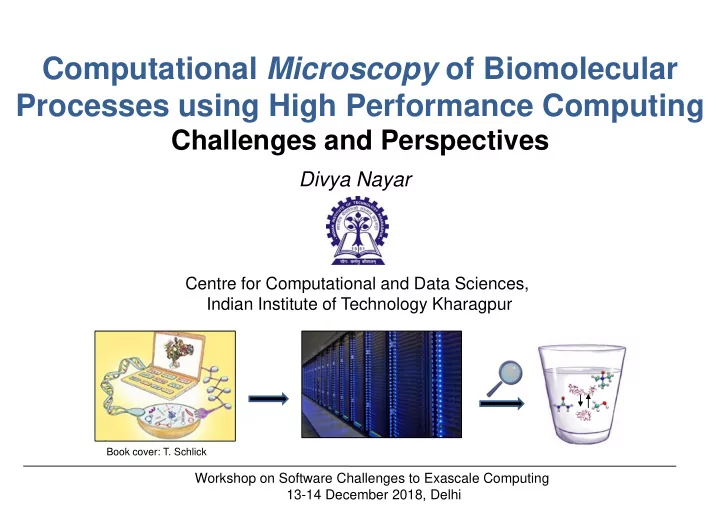

Computational Microscopy of Biomolecular Processes using High Performance Computing Challenges and Perspectives Divya Nayar Centre for Computational and Data Sciences, Indian Institute of Technology Kharagpur Book cover: T. Schlick Workshop on Software Challenges to Exascale Computing 13-14 December 2018, Delhi
A living cell environment: Macromolecular crowding Exascale Protein folding-unfolding ~10-100 µm DNA condensation - Steric interactions Representation of a living cell - Water behaves differently - Dynamics affected Large system sizes ! 2
A living cell environment: Macromolecular crowding Current simulation stage: Tera/Petascale Macromolecular crowding needs to be accounted for ! Representation of a living cell 2
Breakthroughs: Molecular-level understanding Cellular-level systems ? Sanbonmatsu et al. J Struct Biol. 2007, 157, 470 – 480 3
Computational Challenges - Accurate modelling - Large system sizes: N ~10 million atoms - Long simulation times needed: ~ 100 µsec - Large data size generated: ~ 50 TB 4 Needed: Dilute ~ 5X10 atoms 7 Crowded ~ 10 atoms -Efficient parallel simulations Current understanding -GPU acceleration For complete understanding -Making MD packages efficient Tera/Petascale Exascale David S. Goodsell, the Scripps Research Institute (2016). l Feig et al. J. Phys. Chem. B 2012, 116, 599 4 Http://mgl.scripps.edu/people/goodsell/illustration/mycoplasma l Feig et al. J. Mol. Graph. Model . 2013, 45, 144
Molecular dynamics algorithm: Make it efficient ! MD packages (open-source): GROMACS, NAMD, LAMMPS Parallelization schemes: MPI, MPI+OpenMP multi-threading Input configuration Domain decomposition (interactions between (load balancing) molecules: potential energy functions) 10-100 microsecs offload Solving Newton’s equations of GPU acceleration motion Implement latest algorithms like Staggered Mesh Ewald Update configuration Advanced methods too expensive ! Store snapshots of - Numerous parallel MD simulations system - GENESIS package for crowded systems CUDA-enabled analysis codes 5
Benchmark performance of MD simulations GENESIS package GROMACS 5.1.2 package https://www.nvidia.com/en-us/data-center/gpu-accelerated-applications/gromacs Intel Xeon E5-2690 CPUs, each with eight 2.9GHz cores ; System size: ~1 million atoms 6 Jung et al. WIREs Comput . Mol. Sci. 2015 , 5, 310
Example: Aggregation of α -synuclein protein- Parkinson’s disease Enabled predicting binding free energy to form Amyloid Parallel MD simulations of dimers using HPC α – synuclein monomer Amyloid aggregate (Parkinson’s disease) - Dilute solutions !! - Only dimers studied Next step: - ~ 2 µsec (Petascale) Realistic cellular environment - GROMACS 2016 Challenges to be addressed ! Ilie, I.M.; Nayar, D. et al. J. Chem. Theory Comput. 2018 , 14, 3298 7
Centre for Computational and Data Sciences (CCDS) IIT Kharagpur (Estd. March, 2017) 1.3 Peta-Flop Supercomputing facility : National Supercomputing Mission (NSM) . IIT Kharagpur: Nodal Centre for the HR-development activities Interdisciplinary Centre Faculty working in different HPC application domains : Computational Chemistry/Biology, Material science, Atmospheric Modeling, Computational Fluid Dynamics, Geo-Scientific Computations, Modeling and Mining of Heterogeneous Information Network, Computational Physics, Cryptanalysis, Numerical Mathematics, Computational Mechanics, Non-equilibrium Molecular Dynamics Interdisciplinary teaching for Ph.D./ Master’s students 8
Acknowledgements Prof. Nico van der Vegt: Technische Universitaet (TU) Darmstadt, Germany Prof. Wim Briels: University of Twente, Netherlands Dr. Ioana M. Ilie: University of Zurich Dr. Wouter K. den Otter: University of Twente, Netherlands Computational facility : Lichtenberg HPC Cluster, TU Darmstadt Organizers of SCEC 2018 Thank you for your attention ! 9
Example 1: Parallel MD simulations protocol urea Polymer in aqueous urea solution Big question : How do cosolvents protect proteins in the cell under extreme conditions ? Polymer System No. of Total Total CPU Wall clock CPU System size parallel simulation time time per run memory (atoms) simulations time per (core-hours) of 20 ns per core concentration (hrs) 4 μs PNiPAM 26000 1800 9 200 MB 648000 PDEA 72000 2000 4 μs 20 400 MB 3456000 Total 3800 8 μs ~4.1 million MD package : GROMACS 4.6.7 (MPI enabled, 64-bit) - Particle Mesh Ewald: electrostatics - Domain decomposition Hardware : Intel(R) Xeon(R) CPU E5-4650 @ 2.70GHz CPU accelerator: avx2 Computational resources : Lichtenberg High Performance Computing Cluster, TU Darmstadt 8 Nayar et al. Phys. Chem. Chem. Phys ., 2017, 19, 18156.
NAMD 100M atoms on Jaguar XT5 http://www.ks.uiuc.edu/Training/Workshop/Bremen/lectures/day1/Day1b_MD_intro.key.pdf
Molecular dynamics (MD) simulations.. Build Simulate Analyze Protein structure MD packages (open-source): GROMACS, NAMD, LAMMPS Parallelization schemes: -MPI -MPI+OpenMP multi-threading
A living cell: Crowded environment ! ~10-100 µm Protein folding-unfolding DNA condensation Water, ions cosolvent, Crowders Representation of a living cell Microscope 3
Our Computational Microscope: Molecular dynamics simulations Cosolvent Water Molecular simulations Elucidating molecular mechanisms High Performance Computing Book cover: Molecular Modeling and Simulation: An Interdisciplinary Guide; Tamar Schlick 2 van der Vegt, N.F.A.; Nayar, D. J. Phys. Chem. B 2017 , 121, 9986
Molecular dynamics algorithm: Make it efficient ! MD packages (open-source): GROMACS, NAMD, LAMMPS Parallelization schemes: MPI, MPI+OpenMP multi-threading Initial configuration Domain decomposition (load balancing) Bonded forces 10-100 microsecs offload Non-bonded forces Electrostatic forces GPU acceleration (PME) Implement latest algorithms like Integration of Staggered Mesh Ewald equations of motion Update configuration Advanced methods too expensive ! - Numerous parallel MD simulations - GENESIS package for crowded systems Store samples of configurations CUDA-enabled analysis codes 4
Other breakthroughs: Molecular-level understanding Next step: Realistic cellular environment Exascale computing !! Challenges to be addressed Sanbonmatsu et al. J Struct Biol. 2007, 157, 470 – 480 7
Recommend
More recommend